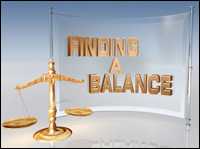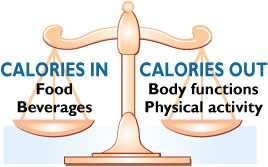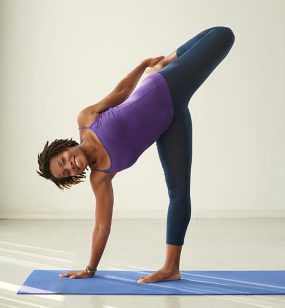Finding a Balance
There’s a lot of talk about the different components of food. Carbohydrates, fats, and proteins, all contain calories. If your diet focus is on any one of these alone, you’re missing the bigger picture.
Video – Finding a Balance

To help people achieve caloric balance and to provide insights into ways in which communities can be involved, CDC-TV included “Finding a Balance” in its “Health Matters” series. This video provides expert perspectives on, the balance of calories and activity, and personal views of people who made changes in their lives to achieve this balance. Watch or download the video (4:18 mins)
The Caloric Balance Equation
Whether you need to lose weight, maintain your ideal weight, or gain weight, the main message is – calories count! Weight management is all about balancing the number of calories you take in with the number your body uses or “burns off.”
- A calorie is a unit of energy supplied by food and beverages. A calorie is a calorie regardless of its source. Carbohydrates, fats, sugars, and proteins all contain calories.
- If your body does not use calories, they are stored as fat.
- Caloric balance is like a scale. To remain in balance and maintain your body weight, the calories consumed must be balanced by the calories used in normal body functions, daily activities, and exercise.

| If you are… | Your caloric balance status is… |
|---|---|
| Maintaining your weight | “in balance.” You are eating roughly the same number of calories that your body is using. Your weight will remain stable. |
| Gaining weight | “in caloric excess.” You are eating more calories than your body is using. You will store these extra calories as fat and you’ll gain weight. |
| Losing weight | “in caloric deficit.” You are eating fewer calories than you are using. Your body is pulling from its fat storage cells for energy, so your weight is decreasing. |
Balancing Diet and Activity to Lose and Maintain Weight Count, Cut, and Burn Calories

If your body weight has not changed for several months, you are in caloric balance. If you need to gain or lose weight, you’ll need to balance your diet and activity level to achieve your goal. To see how many calories you should have in a day to achieve and maintain your recommended weight, see the Dietary Guidelines for Americans, 2015–2020.
It takes about 3,500 calories to lose a pound of body fat,1 You can do this by reducing the calories you take in and increasing the calories you burn. An adult can lose 1 to 2 pounds per week by avoiding or burning 500–1000 calories per day,2
To learn how many calories you are taking in, write down the foods you eat and the beverages you drink, plus the calories they have, each day. By writing down what you eat and drink, you become more aware of everything you are putting in your mouth. Also, begin writing down your physical activity each day and the length of time you do it.
Here are simple paper and pencil tools to assist you:
Physical Activity Diary [PDF-17KB]
Do you want to try a Web-based approach to track your food intake and physical activity? Go to the SuperTracker. The site will give you a personalized diet and activity plan.
Recommended Physical Activity Levels
- For adults, 2 hours and 30 minutes every week (about 22 minutes each day or 50 minutes 3 times per week), of moderate-intensity aerobic activity such as brisk walking. and
- Muscle-strengthening exercise on 2 or more days a week that work all major muscle groups (legs, hips, back, abdomen, chest, shoulders, and arms).
- Increase the intensity or the amount of time that you are physically active to improve health benefits and control body weight.
- Encourage children and teenagers to be physically active for at least 60 minutes each day, or almost every day.
- For more detail, see How much physical activity do you need?
Each person’s body may have different needs for calories and exercise. A healthy lifestyle requires balance in the foods you eat, the beverages you drink, the way you do daily activities, and in the amount of activity in your daily routine. Counting calories all the time is not necessary, but it may help you in the beginning to find out how many calories are in the foods and drinks you consume regularly as you strive to achieve energy balance. The ultimate test of balance is whether or not you are gaining, maintaining, or losing weight.
Questions and Answers about Calories
Q: Are fat-free and low-fat foods low in calories?
A: Not always. Just because a product is fat-free, it doesn’t mean that it is “calorie-free.” Some fat-free and low-fat foods have extra sugars; although there is little or no fat, the calorie amount could be near the same as the original product. And, calories do count! See FAT-Free Versus Regular Calorie Comparison for more information.
Always read the Nutrition Facts food label to find out the calorie content. Remember, this is the calorie content for one serving of the food item, so be sure and check the serving size. If you eat more than one serving, you’ll be eating more calories than is listed on the food label. For more information about the Nutrition Facts food label, visit How to Understand and Use the Nutrition Facts Food Label.
Q: If I eat late at night, will these calories automatically turn into body fat?
A: The time of day doesn’t affect how your body uses calories. The number of calories you eat and the calories you burn affect your weight.
Q: I’ve heard it is more important to worry about carbohydrates than calories. Is this true?
A: By focusing only on carbohydrates, you can still eat too many calories. Also, if you reduce the variety of foods in your diet, you could exclude vital nutrients and not be able to stay on the diet over time.
Q: Does it matter how many calories I eat as long as I’m maintaining an active lifestyle?
A: While physical activity is a vital part of weight control, so is controlling the number of calories you eat. If you take in more calories than you use, you will still gain weight.
Q. What other factors besides diet and behavior contribute to overweight and obesity?
A: Environment and genetic factors may add to causes of overweight and obesity. For more information, see Other Factors in Weight Gain
Want to learn more?
Cutting Calories at Every Meal
You can cut calories by eating foods high in fiber, making better drink choices, avoiding portion size pitfalls, and adding more fruits and vegetables to your eating plan.
Losing Weight
Even a modest weight loss, such as 5 to 10 percent of your total body weight, can produce health benefits.
Physical Activity for a Healthy Weight
Physical activity can increase the number of calories your body uses for energy or “burns off.” The burning of calories through physical activity, combined with reducing the number of calories you eat, creates a “calorie deficit” that can help with weight loss.
- Page last reviewed: November 16, 2016
- Page last updated: November 16, 2016
- Content source:


 ShareCompartir
ShareCompartir